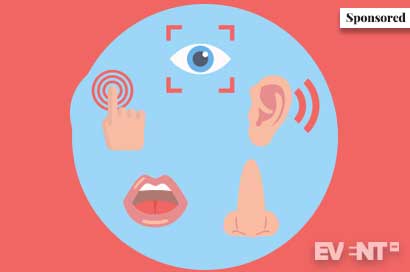This is a sponsored post by Creativiva. More information about Event Manager Blog’s sponsored posts.
Corporate event professionals looking for event entertainment have two priorities in mind, increase engagement and deliver experiences that stick with their audience.
A multi-sensory event is an ideal way to deliver on these objectives because of its powerful imprinting abilities on memory.
Events that stimulate multiple senses create an enticing ambiance and increase engagement as guests interact and share. Here’s how you can use these concepts in your corporate events to provide a much more emotion- and thought-provoking time for your guests.
8 Examples of Multi-Sensory Productions That Get Noticed
Strolling Personalities and Animations
These are not your traditional “candy/cigarette girls.” Today’s strolling personalities are engaging performers outfitted in dream-like fashions.
Lukas Cabalka, Creativiva’s Artistic Director, shared an instance when multiple senses were used to make a big impression at the Wanderluxe Gala, a fundraiser for Herbie Fund of SickKids presented by Air Canada.
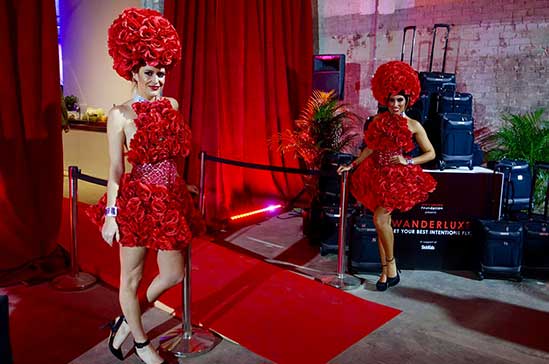

Creativiva, a Toronto-based entertainment company, incorporated rose essential oils into their Rose Girls© costumes, giving the effect of roses wafting around the room as their performers floated past guests
Living Statues
Living statues create amazing photo ops as they strike a pose in front of the audience. Keep in mind these kinds of entertainers should do more than just provide an interesting sight. They may have tactile costumes made of alluring fabrics and use music or sounds to draw a crowd.


Mirrored statues provide amazing photo ops as they dazzle in the lights. Photo courtesy of Creativiva.
Sensory Tunnels
A sensory tunnel employs lighting, sounds, smells, and touch. At first approach, this may appear overwhelming. But consider what Creativiva did when they varied the ambiance in different parts of the tunnel during the VIP event at Evergreen Brickworks.
This allowed guests to enjoy the ones where they felt most comfortable. There was a ”calming” zone, a green-lit area filled with the scent of eucalyptus and freshly cut grass with a soundtrack of calming music and sounds. There was also a “curiosity” zone, filled with blue light and delicious carnival treat scents, set to upbeat invigorating music.
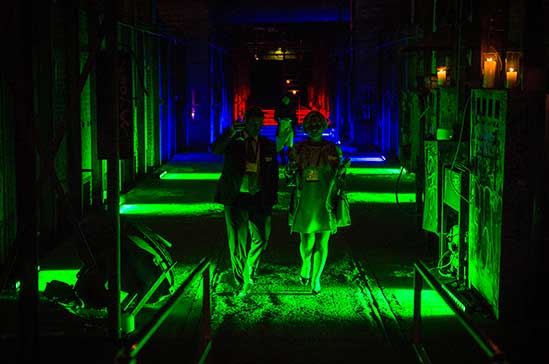

This sensory tunnel turns an ordinary space into a delight for the senses. Photo credit: Creativiva
Live Art Performances
Live creation performances turn crafting and art into entertainment. The art can be personalized to your event or the person requesting it. Either way, it becomes a memorable moment to watch the piece evolve from its first strokes into a masterpiece.
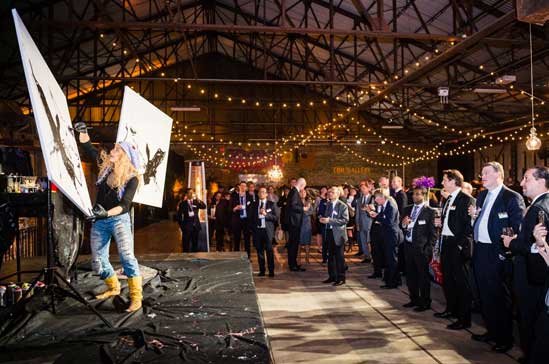

Artist creates exciting designs as part of the performance. Photo courtesy of Creativiva.
Interactive Costume Performers
Costume performers come in a variety of types that can fit any theme. Add some LED lights to their attire and you can have a memorable corporate event. For instance, what could have been an ordinary meet and greet transformed into a “starry night.” At a grand opening of a luxury reality development in Thailand, Creativiva created giant illuminated stars/people.
The performer inside the exclusive costume used movement and color-changing lights to wow the audience. But it wasn’t just a visual performance. The costume also incorporated the tactile sense. The costume reacted to guest touch by changing the light color and moving its spikes.
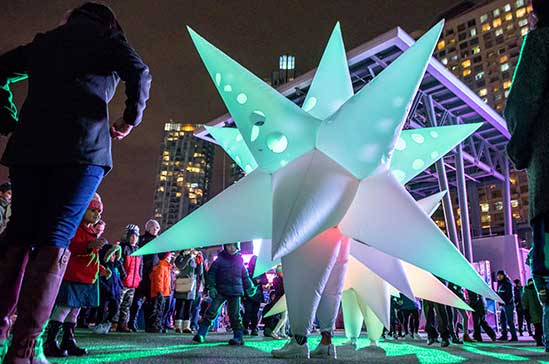

Star costumed performer from “Star Catcher” in Phuket, Thailand. Photo courtesy of Creativiva.
Graffiti and Sidewalk Artists
A graffiti or sidewalk chalk artist not only produces a beautiful piece of art but is also a joy to watch during the creation process. The senses are fully involved as the demonstration combines exciting visuals, the smell of materials, and the tactile opportunities of touching the finished product or shaping the vision with ideas. The creation then becomes decor for the event.
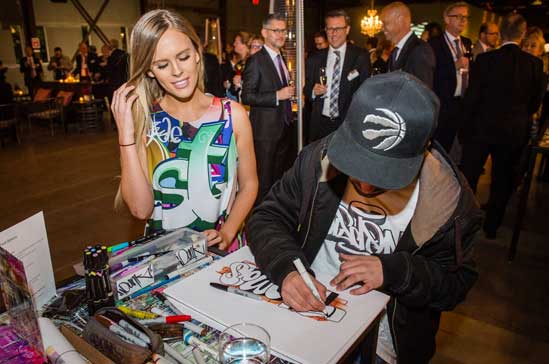

Graffiti artist provides entertainment and a souvenir as he creates personalized name art. Photo credit: Creativiva
360-degree Shows
Another engaging example of a larger multi-sensory installation is a 360-degree show. Everyone in the audience can enjoy their view as the action continues on all fronts and possibly, a variety of mediums. There isn’t a bad seat in the house.
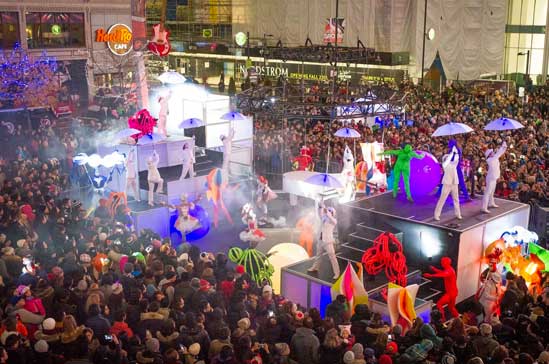

This 360-degree show incorporated multi-sensory performances on a staggered-level stage to ensure every seat was a good one. Photo credit: Creativiva
Live Art Installations
Creating an atmosphere that is a fusion of art, performance, entertainment and decor is one your audience won’t soon forget. This is evident in Creativiva’s NEOS©.
NEOS© are a stunning study and a combination of geometry, the power of color, and movement and statics. Precise mathematical calculations and engineering details lay the framework for NEOS’© creative, proprietary design as the elements that create a character change with the movement.
NEOS© function as live art installations on podiums and as “living sculptures” that occasionally change their poses. When they do, their unusual shapes and the movements they create are impossible to ignore. Guests often stand awestruck in front of this living art. NEOS© were also used as roaming characters interacting with the guests for photo opportunities.
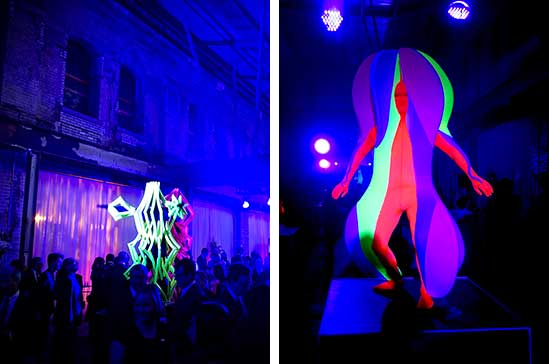

Examples of NEOS© Photo courtesy of Creativiva, a Toronto-based entertainment company
Check out some more multi-sensory examples for your next event:
Now, that we’ve shared some versatile examples with you, let’s get down to what makes an effective multi-sensory event and the benefits behind them.
The Importance of Employing the Five Senses in Your Corporate Entertainment
Multi-sensory events are more than just entertaining. They are memorable and not just because they are fun to behold. Scientists discovered that the auditory, visual and olfactory cortices of the brain each store memories based on the sensory information they are processing.
That means your multi-sensory event is remembered in more areas of the brain, improving the likelihood that the audience will be thinking about your event in the future. Always a good thing.
Let’s take a look at our senses and how they can be used for greater effect.
While all event entertainment employs sight to interest an audience, some also use lighting or projections.
Other corporate event entertainment marries the sense of sight with sound for spectacular results. But if you want to evolve into a much richer audience experience you should consider how the five senses tie in.
Those are:
- Sight: motion, lighting, projections, and impressive stage design
- Sound: music, effects, and soundscapes
- Touch: rich fabrics, interactive walls, misters/fog, and textured surfaces
- Smell: food, flowers, and essential oils
- Taste: menus and samples
SIGHT
Sight is the most often used sense and it is the fuel for most social media shares. Guests love photo ops and sharing visuals on social. Visuals evoke strong emotions. With lighting, projection mapping, extreme visual performances, and immersive theming, your event can be transformed into a visual masterpiece.
SOUND
Sound commands attention. It can be used to create drama, set a tone, and get audience focus. Sounds can also evoke memories and increase emotional response. For instance, some sounds can make an audience tense or more productive (light classical music has been known to increase speed of thought, for instance). Music can also be used for introductions and to establish patterns and expectations on activity or to personalize an experience and create a connection.
TOUCH
Touch can be welcoming or reassuring. But when we speak of touch in events, it’s more than a handshake. We are referring to the complete tactile sense, hands-on learning; kinesthetic interaction with lighting, walls, or costumes; and luxurious fabrics and surfaces are employed for a multi-sensory approach.
SMELL
Smell is one of the best senses to use for evoking emotion through memory. For instance, an Olympic swimmer may experience a rush of adrenaline when they smell chlorine because they associate it with a race. In this situation, it is not only a memory that resurfaces but an emotional reaction as well. Most event planners would love for a smell to remind someone of their event long after it has occurred.
TASTE
The menu can be used to deepen the theme and enliven the experience. Certain tastes and spices are attributed to distinct time periods or cultures. Also, the trend of local sourcing and fresher food creates much stronger flavors and appealing meals for guests. Regional specialities can add interest, pique curiosity, and provide new tastes. The same goes for local beverages.
You may already be thinking that some of these are impossible in your corporate event. Or maybe you’re thinking that when the event is reviewed in its entirety, you do accomplish them all but at different times. However, a savvy corporate event planner learns how to employ many of them at the same time. That cumulative effect of multi-sensory stimulation makes an impression and drives action. That’s why so many retailers use multi-sensory approaches in their stores.
The Benefits of Multi-sensory Events
Not only are senses the way we explore our world, but they also affect mood and influence activity. That’s why it’s important for corporate event planners to understand the power behind the use of the senses.
For instance, citrus smells are known for the invigoration and excitement they bring, while lavender is known for its soothing effect. If you don’t apply this knowledge to create the atmosphere of your choosing, you could be missing out on an opportunity.
Senses can evoke memories, increase productivity, create an atmosphere.
A multi-sensory approach is ideal for corporate events and learning. According to a 2015 report from London & Partners, “Our five senses act as biological learning portals, with all information and stimuli entering our brains through those doors. So the more of the brain that’s activated, the more easily learning occurs and the more likely we are to retain what we learned. Human brains crave unique multi-sensory experiences.”
The survey of more than 600 event planners showed that 78% of them believe multi-sensory events “deliver more memorable and creative experiences” for attendees. The survey also showed that 42% say sensory activations can “help events stand out from the competition.”
So how do you host a successful multi-sensory event?
You can incorporate additional senses into your corporate event entertainment in two ways through:
- focal points
- immersion
Creating sensory focal points is a great solution for smaller budgets and events where you need just a pop of excitement and interest. This method can work well to add surprise and delight in places where a fully immersive experience is not possible or might take away from attention needed in another area like in the case of a board meeting.
A fully immersive experience, on the other hand, is one that surprises the audience on a much larger scale and will be talked about for many days, weeks, or years to come. It tantalizes every sense and, because of its grand scale, offers more opportunity to impact memory.
When senses are involved, it creates an event that remains vivid and can be sparked by that sense being reignited in the future. As in the case of the “Rose Girls©,” it is possible that attendees at that event would think about it again when they smell the delightful fragrance of a rose in bloom. Top of mind is essential to attendees returning to your event and multi-sensory design is a great way to enhance that.
USE SMALL FOCAL POINTS FOR BIG IMPACT
For the most effective kind of multi-sensory event, you want to think of ways to add a heightened sensory experience to every aspect of it, not just the entertainment. For instance, plush seating and exotic fragrances can enhance the guest experience between speakers or entertainment. You can also add wellness focal points that incorporate multiple senses through massage and sound chairs.
CONSIDER THE BIG PICTURE AND GUEST SENSES
Adding smell, taste, and touch, to focal points at your event is not the only way to captivate your guests. The most beguiling is a full-scale way to use the senses through an immersive experience. In immersive events, multiple senses are used throughout, not merely peppered in.
Pro Tip
Don’t worry that your venue is too plain for an extraordinary multi-sensory event.
CUSTOMIZE THE EXPERIENCE TO YOUR AUDIENCE FOR A DEEPER CONNECTION
There are so many ways to incorporate a multi-sensory approach to corporate events but the things that are most critical in deciding how you will do this are the needs and interests of your audience. Some audiences need a multi-sensory, immersive, multi-genre show to impress while others will be amazed by something more calm like a standalone human art installation.
In order to understand their preferences, do your research to find out the kinds of experiences they are used to. Is your demographic younger and frequently attends cutting-edge events? Then immersive is likely the way to go.
If your demographic is older and prefers a more sedate experience, look for ways to insert more multi-sensory components on a smaller scale like in an optional lounge setting or using human art or characters who stroll through the event.
The Obstacles for Event Planners Embracing a Multi-sensory Event
Some of the most common reasons that event planners forgo creating an immersive, multi-sensory event experience are a perceived lack of budget and time for design.
While a totally immersive experience may require a larger budget, there are ways to incorporate the senses for smaller budgets as well. Creating smaller focal points or using individual performers are two of those ways.
Another way is to use sponsorship to cover the costs of a multi-sensory experience. Providing your sponsors with branding opportunities is an easy sell on a production that you know will get noticed and shared.
IN CONCLUSION
There’s a blossoming trend in corporate event entertainment toward full-scale productions with the expectations of your audience driving that. If you’re not delivering on their expectations, you can be sure someone else will. Yet, creating production-quality immersive entertainment isn’t easy. You need a partner that can help deliver on a successful event. Select a group with a creative vision in line with your event that can help you delight your audience for amazing results.

